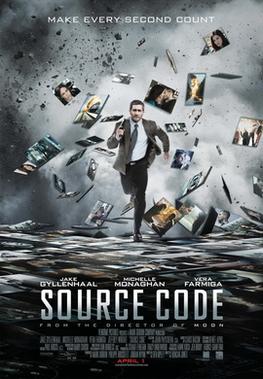
Source code is a tightrope walked by Jake Gylenhaal and held on either ends by screenwriter, Ben Ripley and director, Duncan Jones. Jake Gylenhaal walks it with utmost sincerity yet he wobbles because Ripley and Duncan Jones are pushing him and our patience too hard. He never falls and you sit there hoping he makes it but you come to realize that it was all staged. A gimmick like this doesn't warrant a second viewing.
Colter Stevens (Jake Gylenhaal) wakes up to find himself on a train talking to Christina (Michelle Monaghan), a woman he’s never met. As flustered as he is, he goes in to the toilet to figure things out only to find a face he doesn’t recognize in the mirror. Eight minutes later, the train is blown to smithereens and he’s transported to a secret laboratory. Apparently, he’s been employed by Goodwin (Vera Farmiga), the commanding officer of an army of scientists who repeatedly transport him back (only virtually) for the last eight minutes of the explosion with the hope that he’d help in tracking down, the terrorist involved, and prevent another scheduled explosion. Every time he’s transported back he becomes increasingly callous and desperate, using violence to find what he needs. I loved this part. It’s nice to hurt someone and not have to live through the consequences because after all, it’s an alternate reality. Unfortunately, he seems more interested in finding out about his employers and trying to prevent the explosion even when he’s aware that he isn’t really changing the past. This is where the film begins to falter.
Stevens is constantly told by Goodwin to focus on his mission. I wish the filmmakers did the same. The film ends up fluctuating between finding the terrorist and flirtatious conversations between Stevens and Goodwin (who conveniently turns from a hard ass to a humane do-gooder); and once in a while, his eight-minute built love for Christina. They could've stuck to just finding the terrorist by replaying the events, focused on the characters and kept us guessing. That’s precisely why Groundhog Day worked, with the laughs. But no, they’re clear with their intentions. They want to make money, a lot of it and they won’t compromise on that. Source code was hinged on structure at first, and then it shifted to the relationships of poorly written characters. I understand that there isn't enough room for characterization, but why take on more than you can handle?
The first half was constantly energetic while the second half steadily lost tempo. Another problem with source code is giving us its source code. It’s a science fiction; no one’s going to question it. We just suck it up. I don’t remember anyone asking about the how’s of Inception. They just asked where? Where does it end? That of course, was a word-of-mouth marketing trick. Source Code thinks it has ended on an intelligent note but it isn't smart enough to know that it doesn't.
Rating – 6/10

